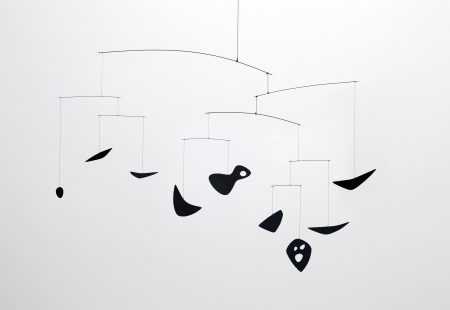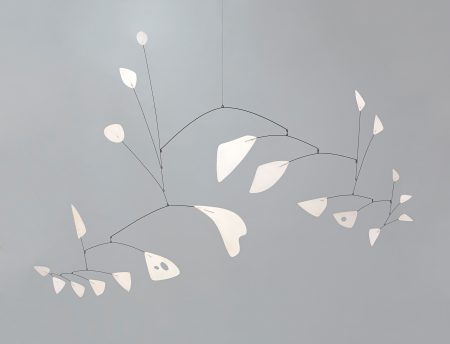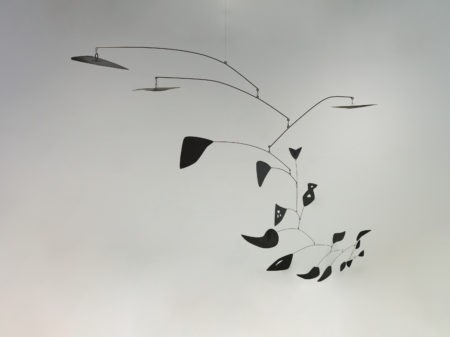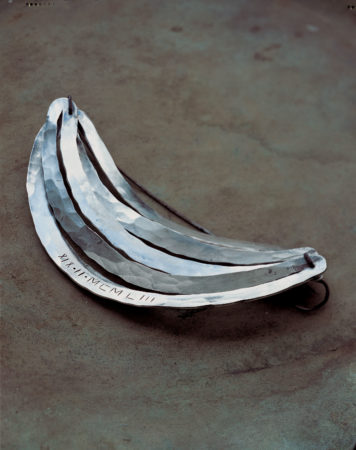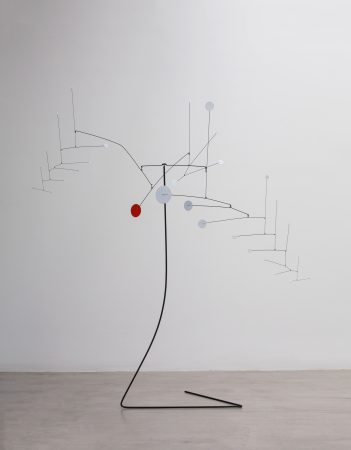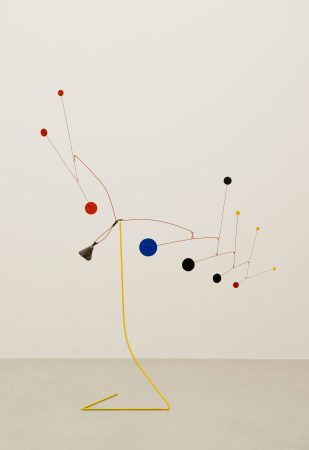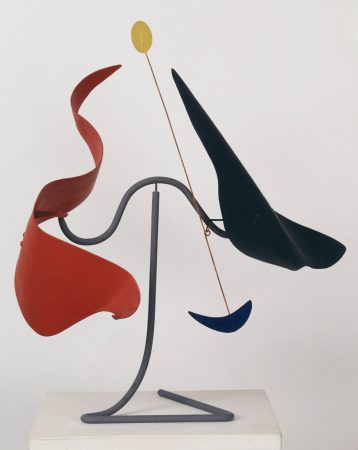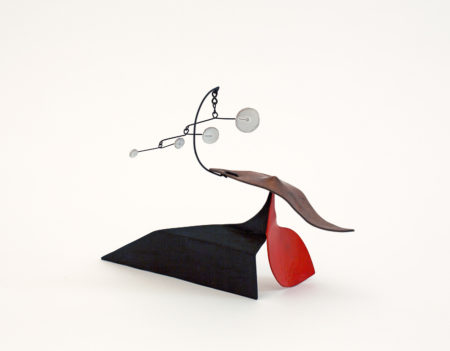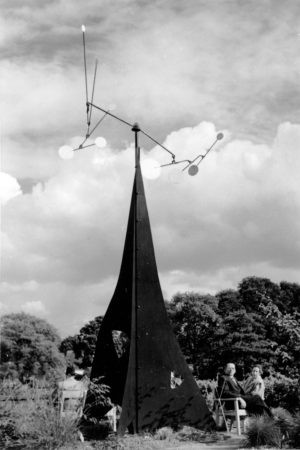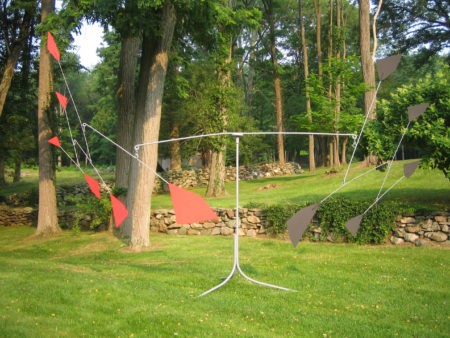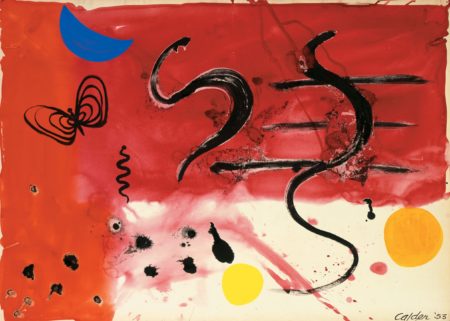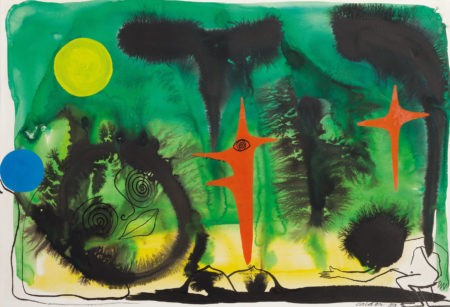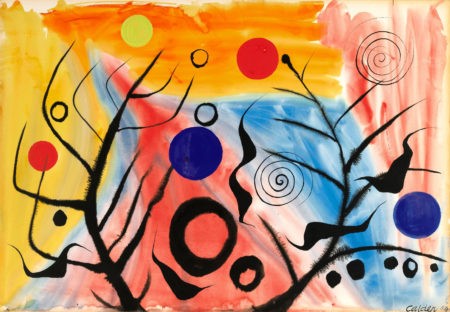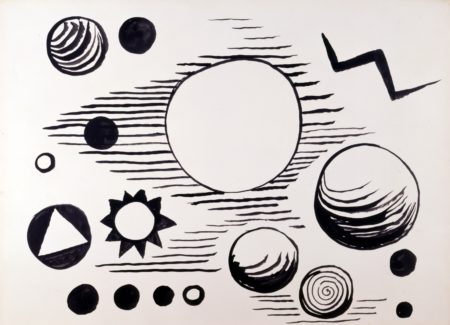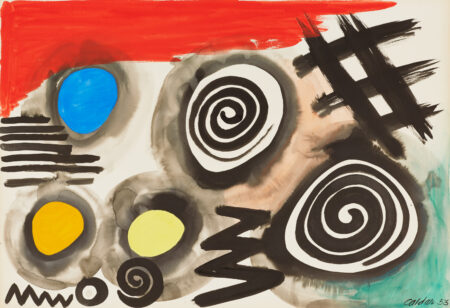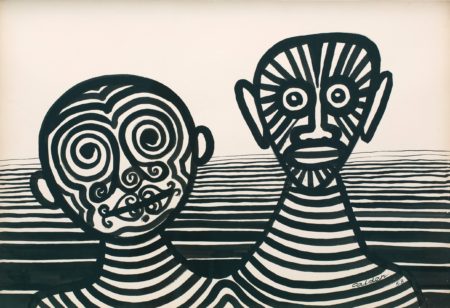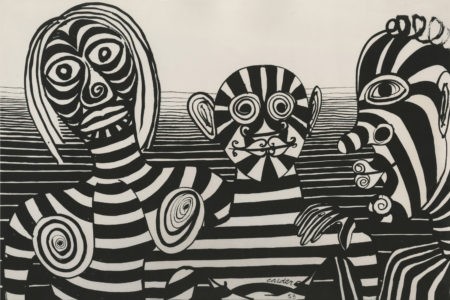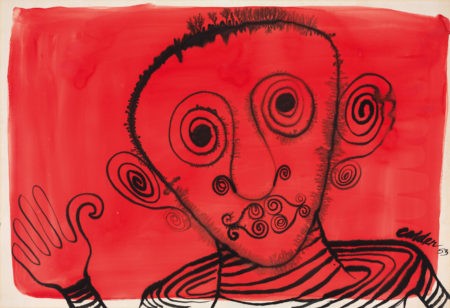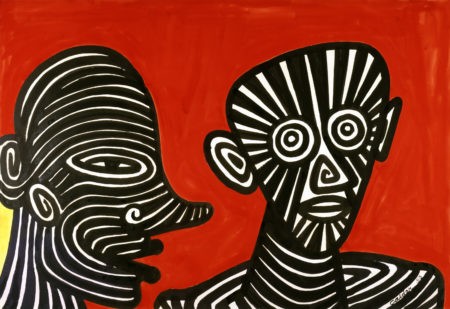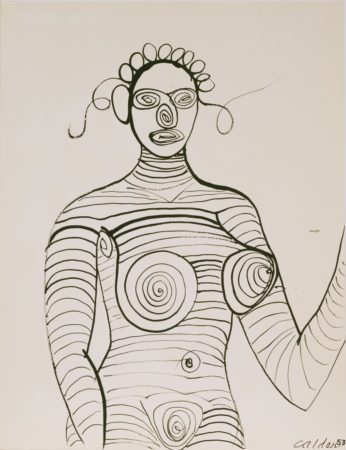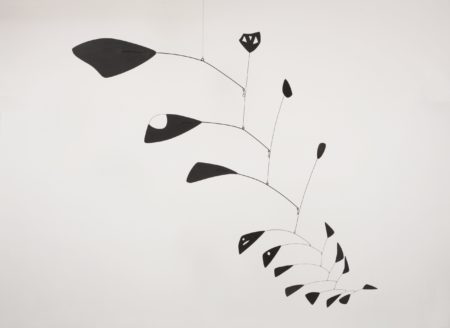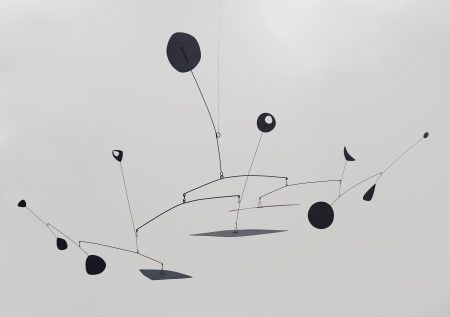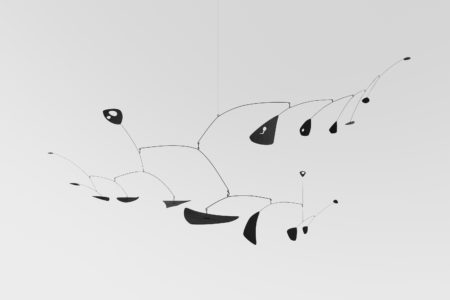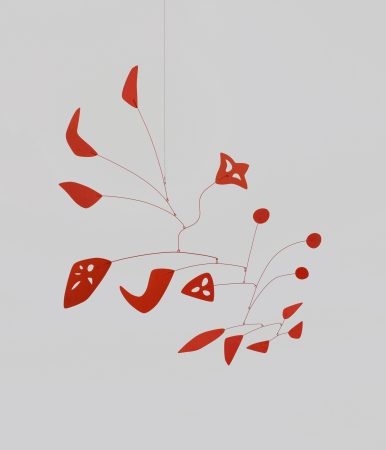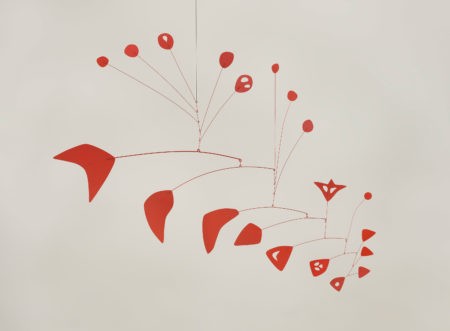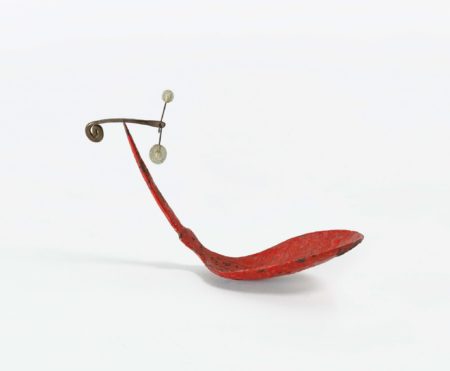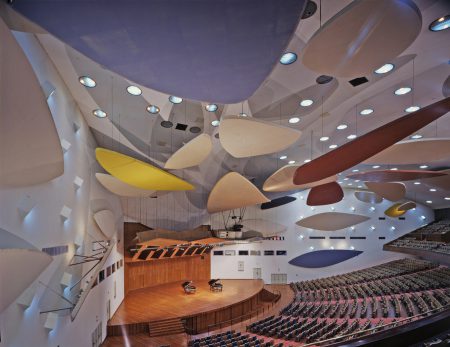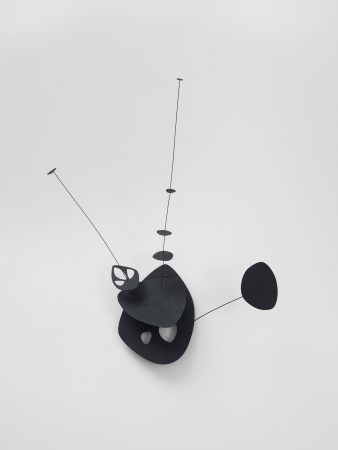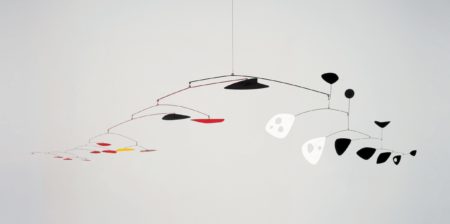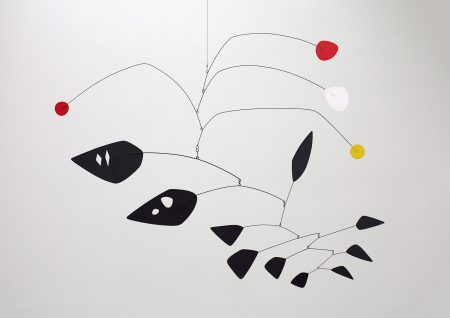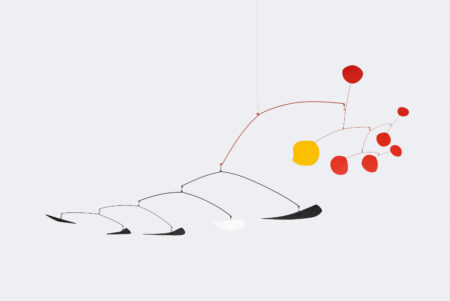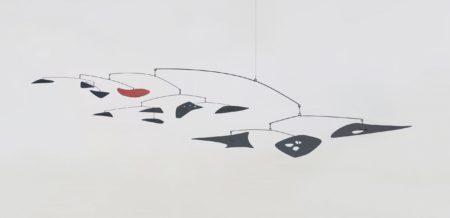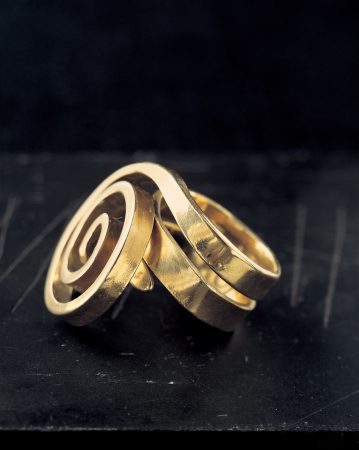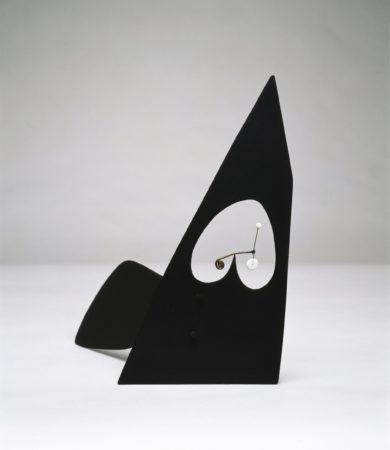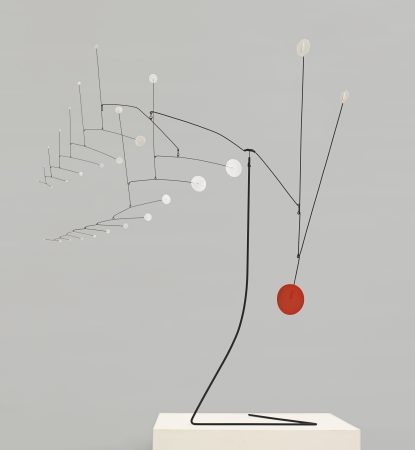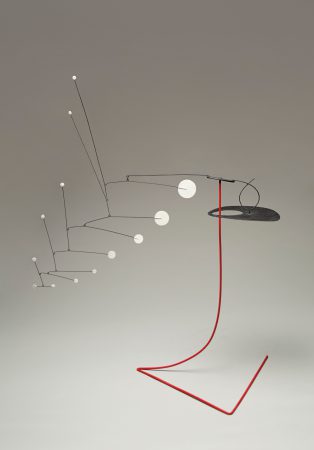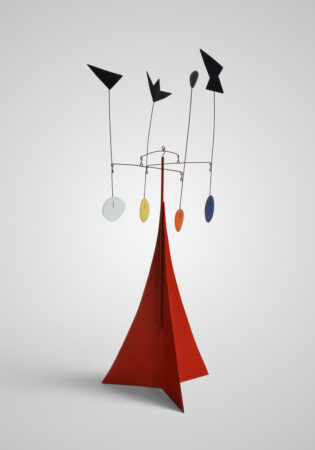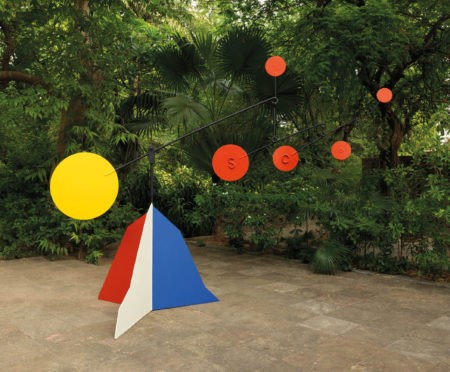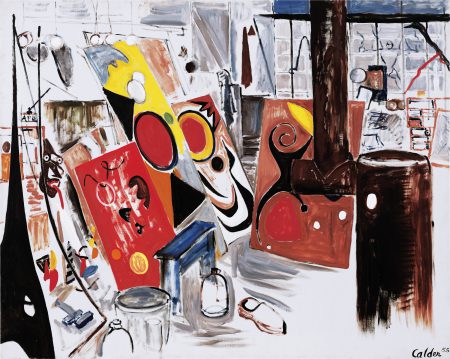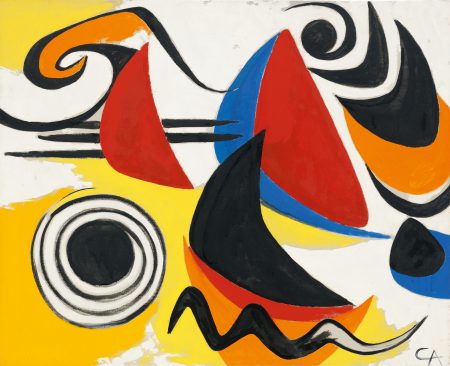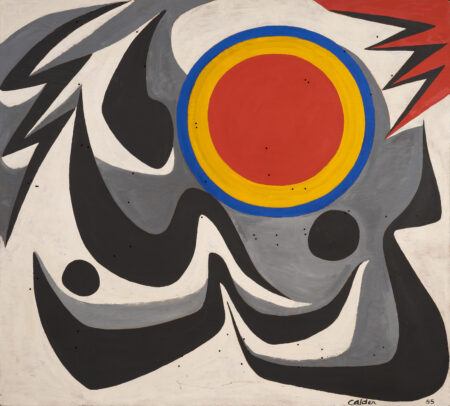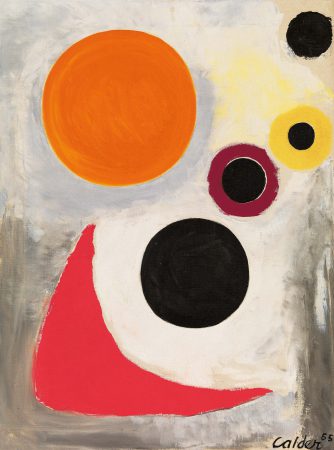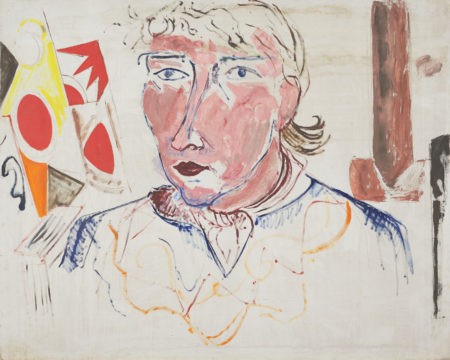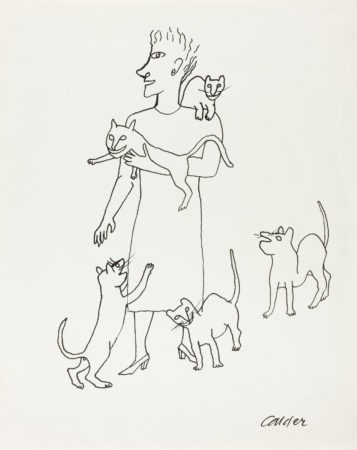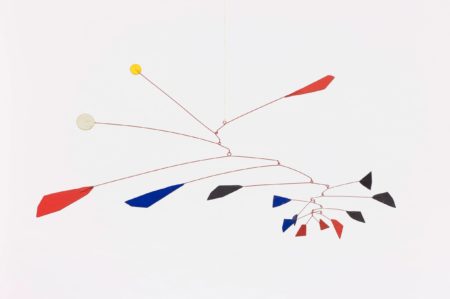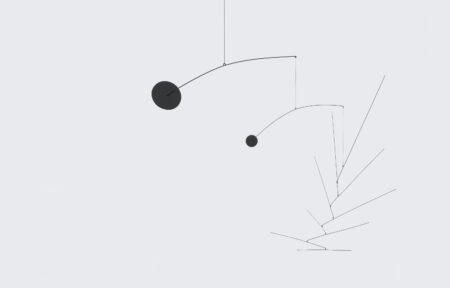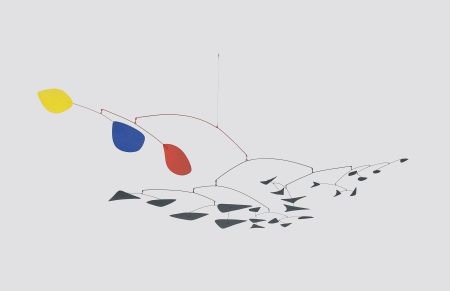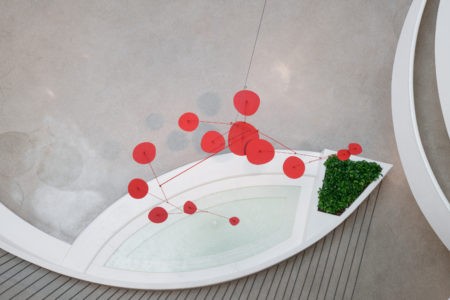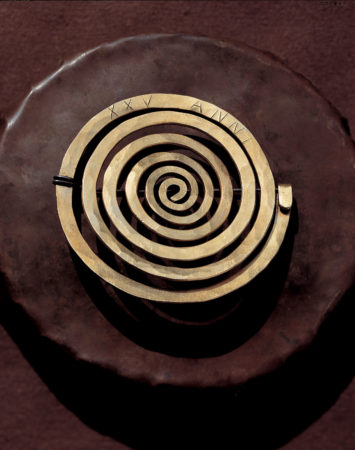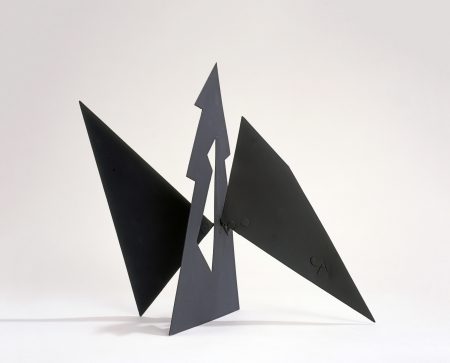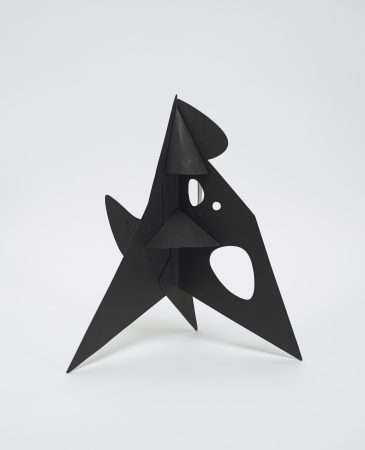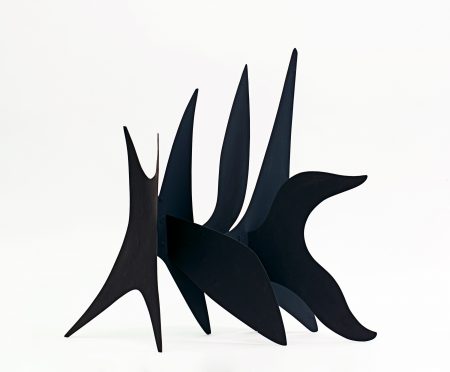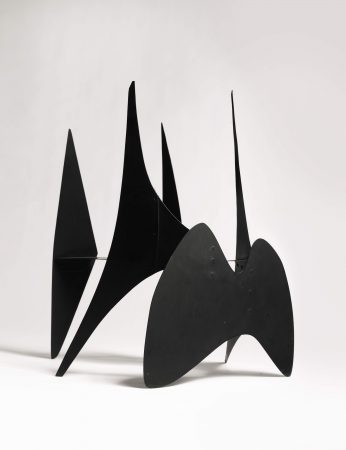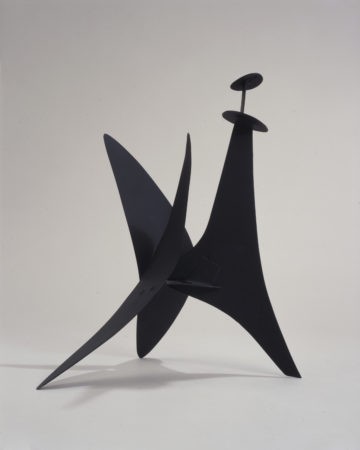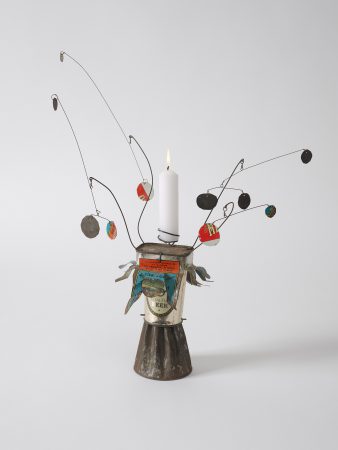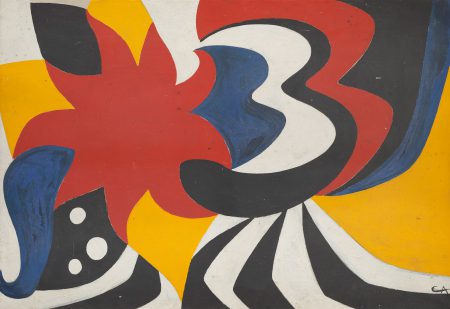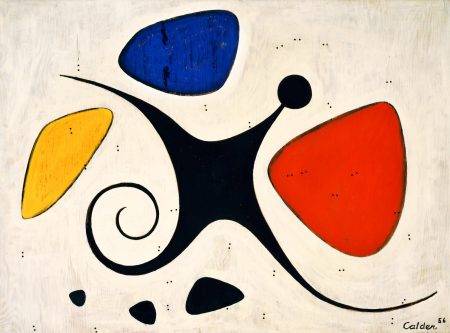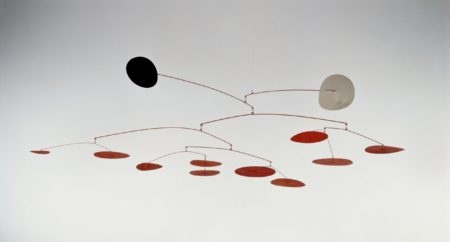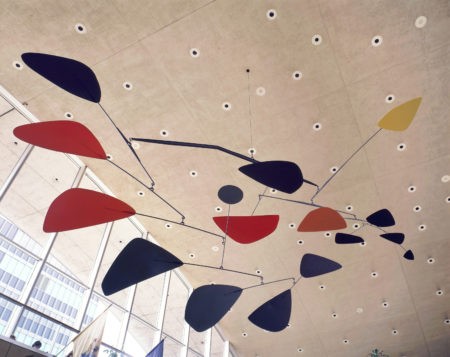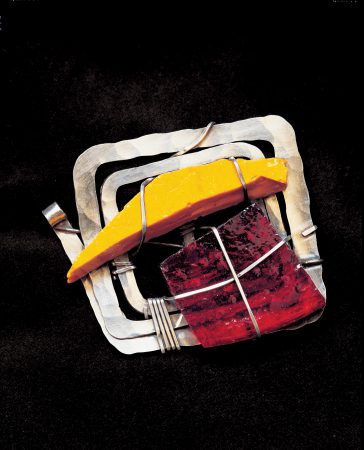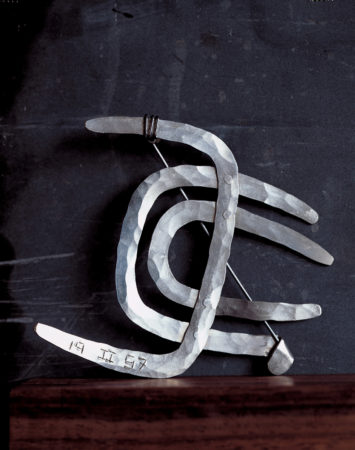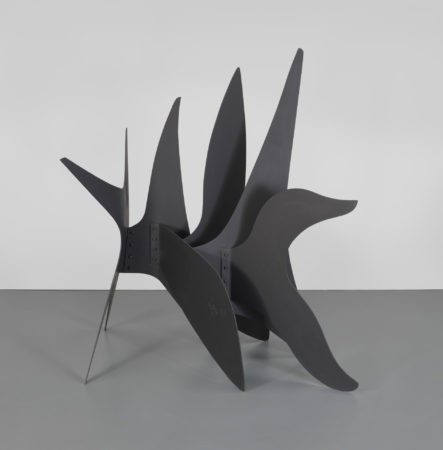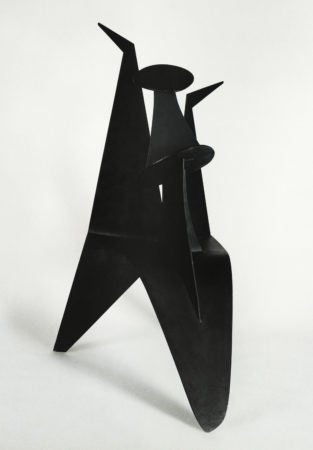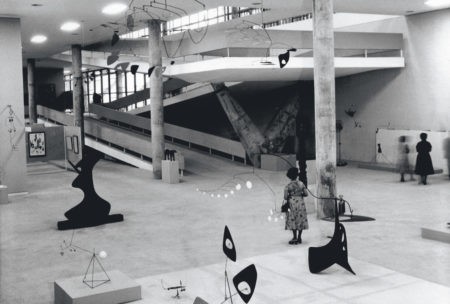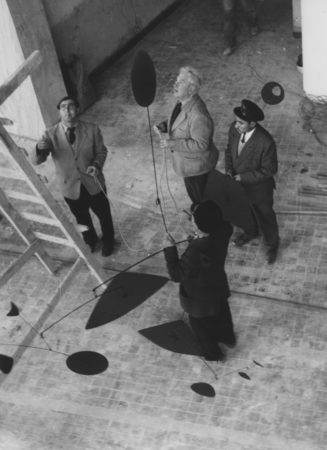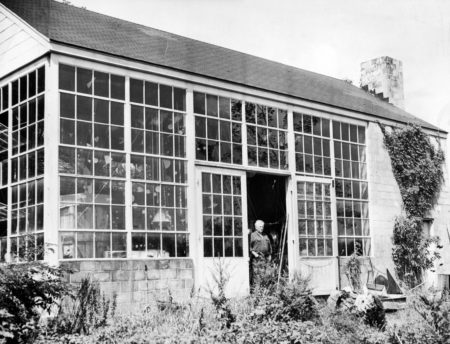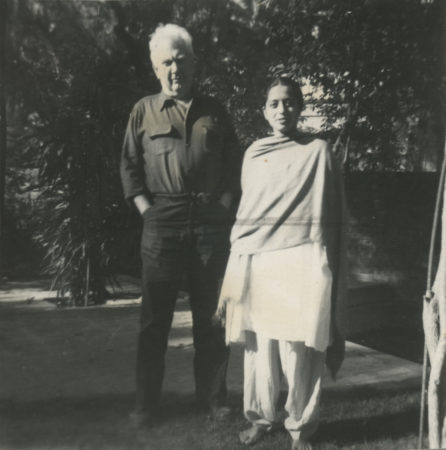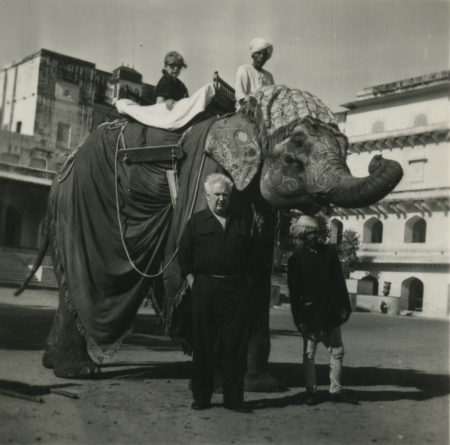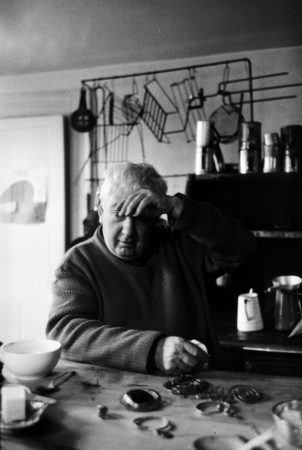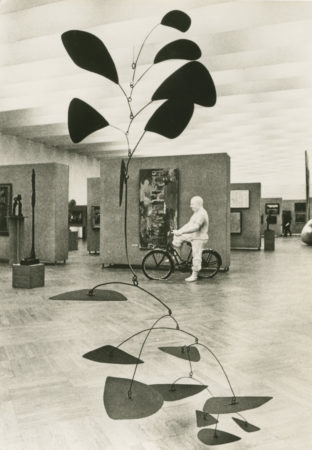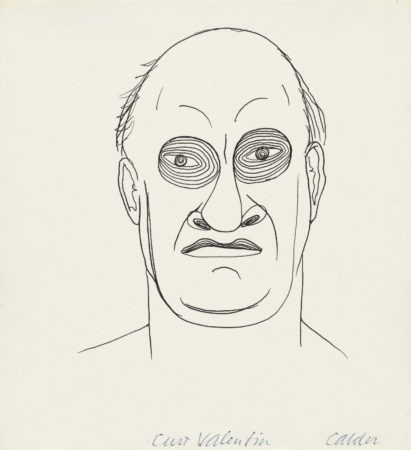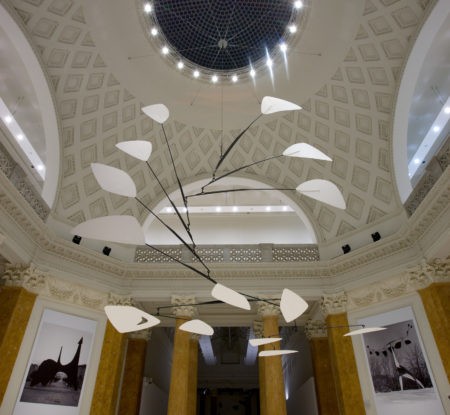Archive
See highlights from 1953–1962 on the timeline Large-scale Developments and Intercontinental Projects
Works
Exhibitions 110
1953
Galerie Otto Ralfs in cooperation with the Städtisches Museum, Braunschweig, Germany. Alexander Calder USA. Mobile. 22 January–18 February 1953. Originated from Galerie Parnass, Wuppertal, Germany.
Solo ExhibitionThe Art Institute of Chicago. Sculpture of the Twentieth Century. 22 January–8 March 1953. Originated from the Philadelphia Museum of Art and Fairmount Park Art Association.
Group ExhibitionThe Museum of Modern Art, New York. The Unknown Political Prisoner. 28 January–8 February 1953.
Group ExhibitionHanna Bekker vom Rath/Frankfurter Kunstkabinett, Frankfurt am Main. Alexander Calder, Paul Fontaine, Louise Rösler. 22 February–22 March 1953. Originated from the solo exhibition at Galerie Parnass, Wuppertal, Germany.
Group ExhibitionTate Gallery, London. The Unknown Political Prisoner. 14 March–30 April 1953. Originated from the Museum of Modern Art, New York.
Group ExhibitionWalker Art Center, Minneapolis. Alexander Calder Mobiles. 22 March–19 April 1953.
Solo ExhibitionKarl-Ernst-Osthaus-Museum, Hagen, Germany. Alexander Calder Mobile. 22 March–19 April 1953. Originated from Galerie Parnass, Wuppertal, Germany.
Solo ExhibitionMeta Mold Aluminum Company, Cedarburg, Wisconsin. An Exhibition of Contemporary Art Collected by American Business. April 1953.
Group ExhibitionMusée National d’Art Moderne, Paris. 12 Peintres et Sculpteurs Américains Contemporains. 24 April–7 June 1953.
Group ExhibitionThe Museum of Modern Art, New York. Sculpture of the Twentieth Century. 29 April–7 September 1953. Originated from the Philadelphia Museum of Art and Fairmount Park Art Association.
Group ExhibitionGalerie Hella Nebelung, Düsseldorf. Alexander Calder (USA) Mobile. 3–28 May 1953. Originated from Galerie Parnass, Wuppertal, Germany.
Solo ExhibitionFrank Perls Gallery, Beverly Hills. Alexander Calder Mobiles. 11 May–13 June 1953. Originated from the Walker Art Center, Minneapolis.
Solo ExhibitionMuseum am Ostwall, Dortmund, Germany. 6–30 June 1953. Originated from Galerie Parnass, Wuppertal, Germany.
Solo ExhibitionMeta Mold Aluminum Company, Cedarburg, Wisconsin. Art For Everyone. July 1953.
Group ExhibitionStudio für zeitgenössische Kunst, Kaiser Wilhelm Museum, Krefeld, Germany. Alexander Calder. Mobiles. Drahtplastiken als Mobiles. Blechplättchenspiel der Mobiles. 5–26 July 1953. Originated from Galerie Parnass, Wuppertal, Germany.
Solo ExhibitionSan Francisco Museum of Art. Mobiles by Alexander Calder. 4–27 September 1953. Originated from the Walker Art Center, Minneapolis.
Solo ExhibitionWadsworth Atheneum, Hartford. Alexander Calder: Mobiles / Naum Gabo: Kinetic Constructions and Constructions in Space. 16 October–28 November 1953.
Group ExhibitionMuseu de Arte Moderna, São Paulo, Brazil. II Bienal do Museu de Arte Moderna de São Paulo. 15 December 1953–28 February 1954.
Group ExhibitionCurt Valentin Gallery, New York. Sculpture and Sculptors Drawings. 22 December 1953–24 January 1954.
Group Exhibition1954
American University, Beirut. Alexander Calder. February 1954.
Solo ExhibitionKestnergesellschaft, Hanover, Germany. Alexander Calder: Stabiles, Mobiles, Gouachen. 18 March–2 May 1954.
Solo ExhibitionThe Newark Museum, New Jersey. Enjoy Modern Art I. 1 May–27 September 1954.
Group ExhibitionGalerie des Cahiers d’Art, Paris. Gouaches récentes de Calder. 5–29 May 1954.
Solo ExhibitionGalerie Rudolf Hoffmann, Hamburg, Germany. Calder. 12–30 June 1954.
Solo ExhibitionMusée National d’Art Moderne, Paris. Le Dessin Contemporain Aux États-Unis. 1 October–1 November 1954.
Group ExhibitionGalerie Maeght, Paris. Aix. Saché. Roxbury. 1953–54. 13 November–15 December 1954.
Solo ExhibitionVancouver Art Gallery. The Solomon R. Guggenheim Museum, A Selection from the Museum Collection. 16 November–12 December 1954.
Group ExhibitionGalerie Denise René, Paris. Premier Salon de la Sculpture Abstraite. 10 December 1954–15 January 1955.
Group Exhibition1955
The Lefevre Gallery, London. Mobiles by Calder. January 1955.
Solo ExhibitionCity Art Museum of St. Louis, Missouri. A Tribute to Curt Valentin. 14 January–14 February 1955.
Group ExhibitionJehangir Art Gallery, Bombay. 25 March 1955.
Solo ExhibitionMusée National d’Art Moderne, Paris. Modern Art in the United States. 30 March–15 May 1955.
Group ExhibitionGalerie Denise René, Paris. Le Mouvement. 6 April–15 May 1955.
Group ExhibitionGraduate School of Design, Harvard University, Cambridge, Massachusetts. Calder. 25 April–25 May 1955.
Solo ExhibitionCurt Valentin Gallery, New York. Alexander Calder. 17 May–4 June 1955.
Solo ExhibitionMuseum Fridericianum, Kassel, Germany. Documenta: Kunst des XX. jahrhunderts: Internationale Ausstellung. 15 July–18 September 1955.
Group ExhibitionMuseo de Bellas Artes, Caracas, Venezuela. Exposiciòn Calder. 11–25 September 1955.
Solo ExhibitionMilwaukee Art Institute, Wisconsin. Calder Mobiles and Stabiles. 9 December 1955–19 January 1956.
Solo Exhibition1956
Perls Galleries, New York. Calder. 6 February–10 March 1956.
Solo ExhibitionMemorial Union Gallery, University of Wisconsin, Madison. Calder Mobiles and Stabiles. 16 February–5 March 1956. Originated from the Milwaukee Art Institute, Wisconsin.
Solo ExhibitionGalleria dell’Obelisco, Rome. Calder. 14–31 March 1956.
Solo ExhibitionSioux City Art Center, Iowa. Calder Mobiles and Stabiles. 26 March–13 April 1956. Originated from the Milwaukee Art Institute, Wisconsin.
Solo ExhibitionGalleria d’Arte del Naviglio, Milan. Alexander Calder. 7–17 April 1956.
Solo ExhibitionGalerie Lucie Weill, Paris. Calder. 3–26 May 1956.
Solo ExhibitionBeloit College, Wisconsin. Calder Mobiles and Stabiles. 8 May–10 June 1956. Originated from the Milwaukee Art Institute, Wisconsin.
Solo ExhibitionKunstmuseum, Basel. Sammlung Richard Doetsch-Benziger. 9 June–8 July 1956.
Group ExhibitionCircolo della Cultura e delle Arti, Trieste, Italy. Calder. 23 June–7 July 1956.
Solo ExhibitionDavison Art Center, Wesleyan University, Middletown, Connecticut. 28 June–31 August 1956.
Solo ExhibitionMusée Picasso, Château Grimaldi, Antibes. Gouaches–Dessins–Mobiles de Calder. 1 August–1 October 1956.
Solo ExhibitionUniversity of Michigan Museum of Art, Alumni Memorial Hall, Ann Arbor. Calder Mobiles and Stabiles. 16 September–14 October 1956. Originated from the Milwaukee Art Institute, Wisconsin.
Solo ExhibitionThe Institute of Contemporary Art, Boston. Jewelry and Drawings by Alexander Calder. 18 October–21 November 1956.
Solo ExhibitionDepartment of Fine Arts, Northern Illinois State College, DeKalb. Calder Mobiles and Stabiles. 29 October–19 November 1956. Originated from the Milwaukee Art Institute, Wisconsin.
Solo ExhibitionSouth Bend Art Association, Indiana. Calder Mobiles and Stabiles. 30 November–25 December 1956. Originated from the Milwaukee Art Institute, Wisconsin.
Solo ExhibitionPalais des Beaux-Arts, Brussels. L’art dans les collections Universitaires Americaines. 12–30 December 1956.
Group Exhibition1957
Museum of Art, University of Kansas, Lawrence. Calder Mobiles and Stabiles. 10–30 January 1957. Originated from the Milwaukee Art Institute, Wisconsin.
Solo ExhibitionFort Wayne Art School and Museum, Indiana. Calder Mobiles and Stabiles. 10 February–3 March 1957. Originated from the Milwaukee Art Institute, Wisconsin.
Solo ExhibitionFrank Perls Gallery, Beverly Hills. Alexander Calder. 18 February–16 March 1957.
Solo ExhibitionWorld House Galleries, New York. 4 Masters Exhibition: Rodin, Brancusi, Gauguin, Calder. 28 March–20 April 1957.
Group ExhibitionKunsthalle Basel. Alexander Calder. 22 May–23 June 1957.
Solo ExhibitionStädelsches Kunstinstitut, Frankfurt. Alexander Calder. 17 July–25 August 1957. Originated from Kunsthalle Basel, Switzerland.
Solo ExhibitionUffici Palazzo dell’arte al Parco, Milan. XI Triennale di Milano. 27 July–4 November 1957.
Group Exhibition1958
Galerie Blanche, Stockholm. Alexander Calder: Mobiles and Stabiles. 1958.
Solo ExhibitionCorcoran Gallery, Washington, D.C. Contemporary American Artists Series #27: Alexander Calder. 25 January–2 March 1958.
Solo ExhibitionGalerie Artek, Helsinki. Alexander Calder: Exposition. 29 January–2 June 1958.
Solo ExhibitionPerls Galleries, New York. Calder: Recent Works. 10 February–8 March 1958.
Solo ExhibitionBrussels Universal and International Exhibition, United States Pavilion. American Art: Four Exhibitions. 17 April–18 October 1958.
Group ExhibitionBrussels Universal and International Exhibition, Palais International des Beaux-Arts. 50 Ans d’Art Moderne. 17 April–19 October 1958.
Group ExhibitionThe Glory Folk (1958). One of four Chamber Ballets choreographed by John Butler; set includes a stabile and mobile designed by Calder; music arranged by Lucy Brown; costumes by Geoffrey Holder.
Theatrical PerformanceJohn F. Kennedy International Airport, Port Authority of New York and New Jersey, New York. Flight (.125). August 1958.
Installation / Dedication CeremonyDepartment of Fine Arts, Carnegie Institute, Pittsburgh. The 1958 Pittsburgh Bicentennial International Exhibition of Contemporary Painting and Sculpture. 5 December 1958–8 February 1959.
Group ExhibitionUNESCO, Paris. Spirale. 23 December 1958.
Installation / Dedication Ceremony1959
Musée Galliéra, Paris. L’Age Mécanique. March–May 1959.
Group ExhibitionGalerie Maeght, Paris. Calder: Stabiles. 6 March–13 April 1959.
Solo ExhibitionGalerie des Cahiers, Paris, and U.S. Centre Culturel American. Les Années Vingt: Les Écrivains Américains à Paris et leurs Amis. 1920–1930. 11 March–25 April 1959.
Group ExhibitionStedelijk Museum, Amsterdam. Alexander Calder, Stabilen, Mobilen. 15 May–22 June 1959.
Solo ExhibitionMuseum Fridericianum, Orangerie, Bellvueschlos, Kassel, Germany. II. documenta ’59. Kunst nach 1945: Malerei, Skulptur, Druckgrafik internationale Ausstellung. 11 July–11 October 1959.
Group ExhibitionKunsthalle Hamburg, Germany. Calder: Stabiles 1957–59, Mobiles 1956–58. 18 July–30 August 1959. Originated from the Stedelijk Museum, Amsterdam.
Solo ExhibitionAmerican National Exhibition, Sokolniki Park, Moscow. American Painting and Sculpture 1930–1959: The Moscow Exhibition. 24 July–4 September 1959.
Group ExhibitionMuseum Haus Lange, Krefeld, Germany. Alexander Calder, Stabilen, Mobilen. 13 September–25 October 1959. Originated from the Stedelijk Museum, Amsterdam.
Solo ExhibitionMuseu de Arte Moderna do Rio de Janeiro. Alexander Calder: Escultura, Guache. 23 September–25 October 1959.
Solo ExhibitionWhitney Museum of American Art, New York. Painting and Sculpture from the American National Exhibition in Moscow. 28 October–15 November 1959. Originated from American National Exhibition, Sokolniki Park, Moscow.
Group ExhibitionKunsthalle Mannheim, Germany. Alexander Calder, Stabilen, Mobilen. 7 November–13 December 1959. Originated from the Stedelijk Museum, Amsterdam.
Solo Exhibition1960
Haus der Jugend, Wuppertal-Barmen, Germany. Alexander Calder, Stabilen, Mobilen. 10 January–21 February 1960. Originated from the Stedelijk Museum, Amsterdam.
Solo ExhibitionPerls Galleries, New York. Alexander Calder “1960.” 15 March–9 April 1960.
Solo ExhibitionPalais des Beaux-Arts, Brussels. Alexander Calder. 3 April–1 May 1960. Originated from the Stedelijk Museum, Amsterdam.
Solo ExhibitionGaleria Ambiente, São Paulo, Brazil. 9 May 1960.
Solo ExhibitionKunstgewerbemuseum, Zurich. Kinetische Kunst; Alexander Calder, Mobiles und Stabiles aus den letzten Jahren. 21 May–26 June 1960. Originated from the Stedelijk Museum, Amsterdam.
Solo Exhibition1961
Wilmington Society of Fine Arts, Delaware Art Center. Calder / Alexander Milne, Alexander Stirling, Alexander. 7 January–19 February 1961.
Group ExhibitionThe Museum of Modern Art, New York. The James Thrall Soby Collection. 1 February–4 March 1961.
Group ExhibitionPerls Galleries, New York. Alexander Calder / Joan Miró. 21 February–1 April 1961.
Group ExhibitionStedelijk Museum, Amsterdam. Bewogen–Beweging. 10 March–17 April 1961.
Group ExhibitionKatonah Gallery, New York. Alexander Calder. 15 October–14 November 1961.
Solo ExhibitionLincoln Gallery, London. Alexander Calder: The Gouaches. November 1961.
Solo ExhibitionJoan Peterson Gallery, Boston. Calder. 29 November–30 December 1961.
Solo Exhibition1962
Musée des Arts Décoratifs, Paris. Antagonismes 2: L’Objet. 1962.
Group ExhibitionThe Arts Club of Chicago. Wit and Humor. 28 February–31 March 1962.
Group ExhibitionArkansas Arts Center, Little Rock. The Works of Alexander Calder. 1 March–1 April 1962.
Solo ExhibitionPerls Galleries, New York. Alexander Calder: 1962. 20 March–21 April 1962.
Solo ExhibitionSeattle World’s Fair. American Sculpture Since the 1950s. April–October 1962.
Group ExhibitionGalerie Blanche, Stockholm. Mobiles. May–June 1962.
Solo ExhibitionHistorical Photos 54
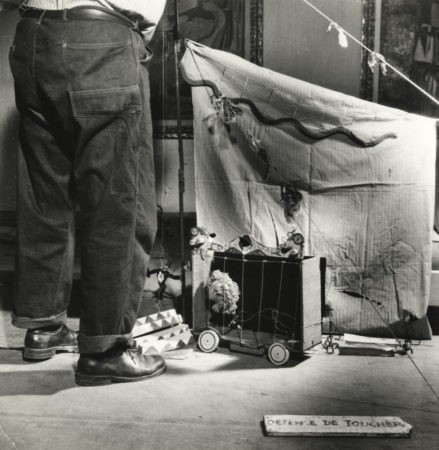

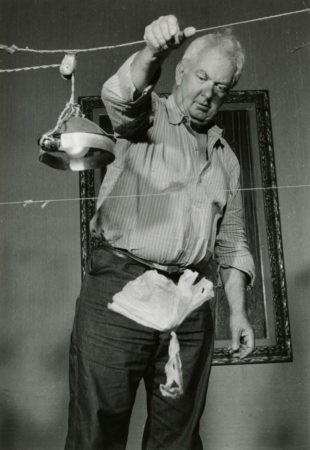
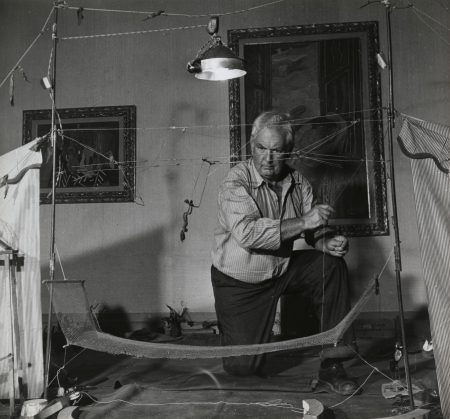
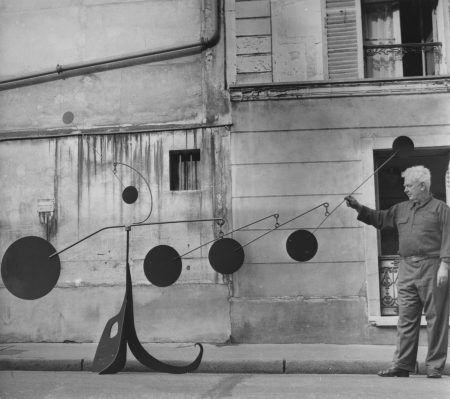

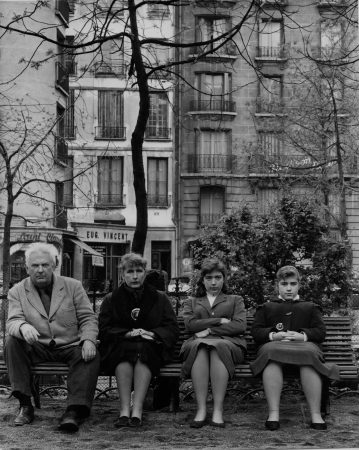

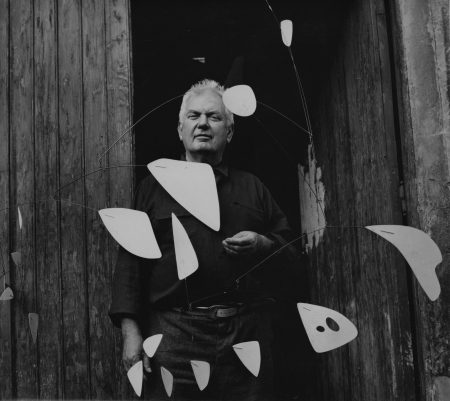
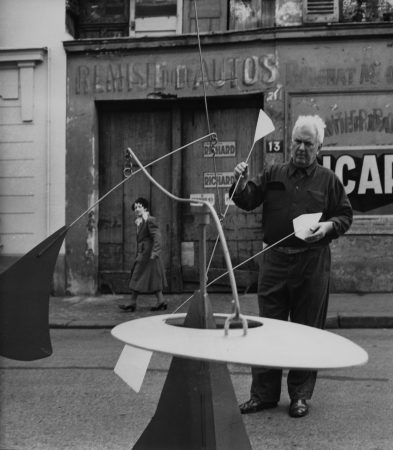
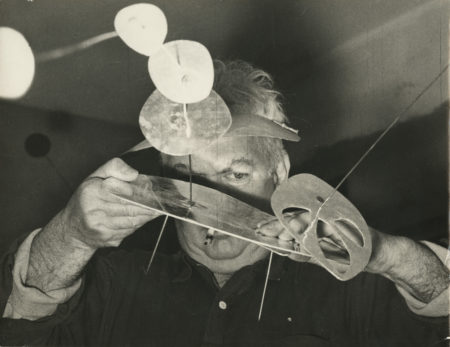

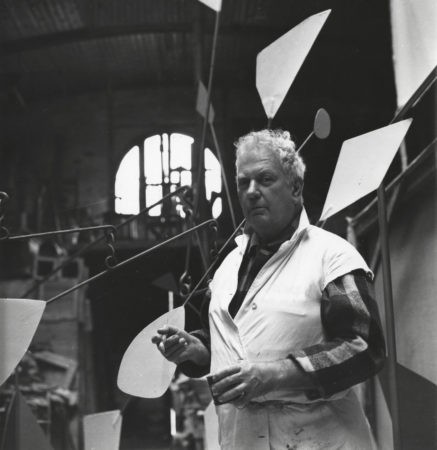
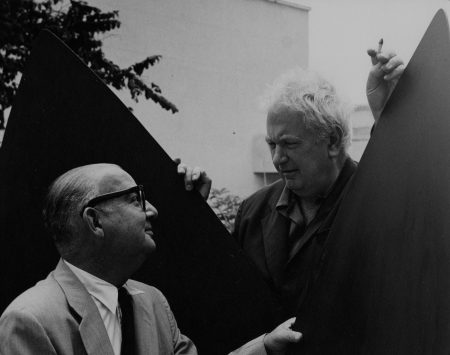

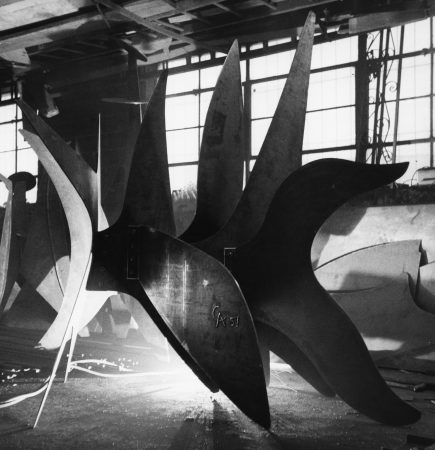

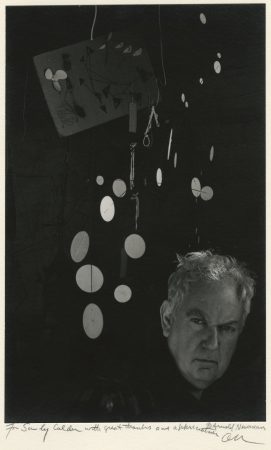


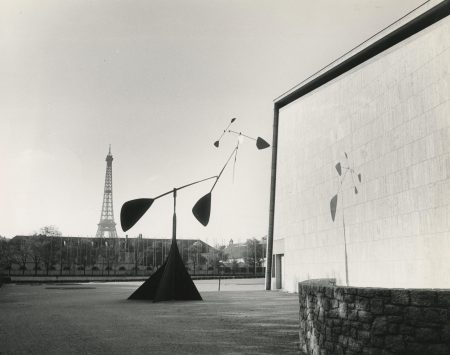
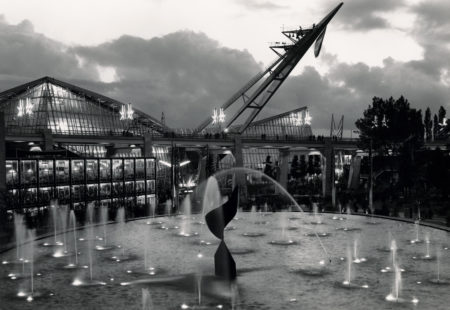
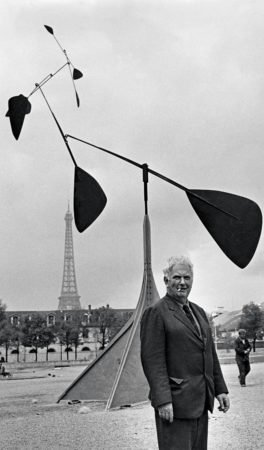
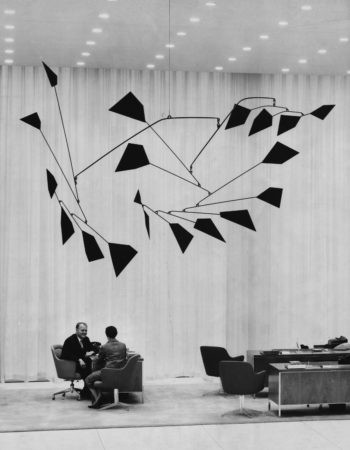
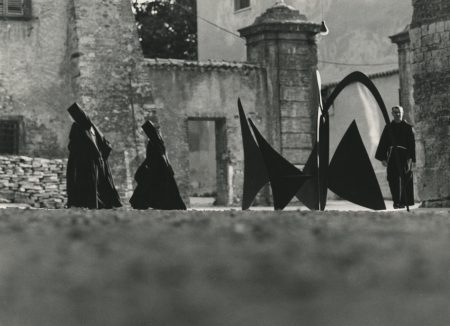
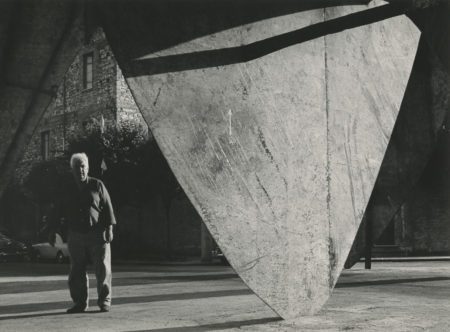
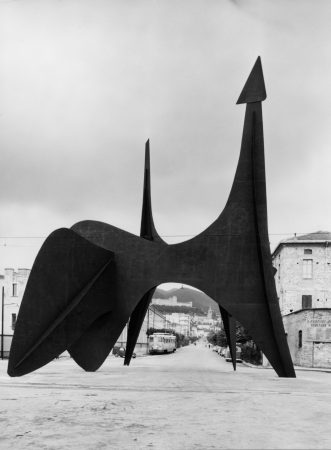
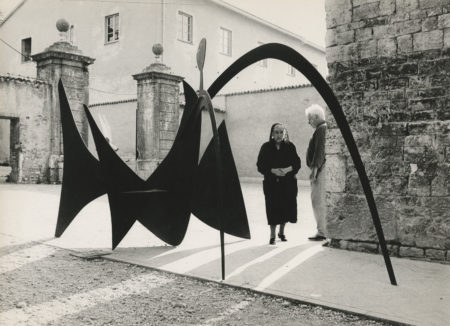
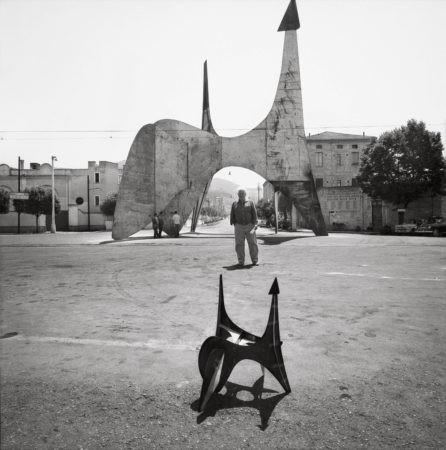
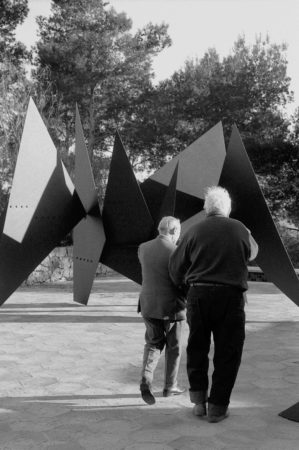
Chronology 126
Calder performs Cirque Calder in the Roxbury studio.
CF, Stillman to BreuerFrank Perls Gallery, Beverly Hills, exhibits “Alexander Calder Mobiles,” previously shown at the Walker Art Center, Minneapolis, from 22 March–19 April.
CF, exhibition fileThe Calder family arrives at Le Havre after an eight-day voyage on the Flandre. Also on board is Ernest Hemingway. He appeared suddenly and I presented myself, but it was not much use. For I had nothing to say to him and he had nothing to say to me. And that went for Louisa too.
CF, Calder to Valentin, 26 May; Calder 1966, 213The Calders arrive in the hamlet of Les Granettes in Aix-en-Provence. Their house, Mas des Roches, has little water and no electricity. Calder uses the carriage shed as his studio, where he works on gouaches. At a blacksmith shop nearby, he makes a series of large standing
mobiles conceived for the outdoors.
The Calders visit Jean Davidson in the Loire Valley. Jean has purchased a mill house Moulin Vert, in the tiny town of Saché.
Calder 1966, 219–20; CF, Calder to Peggy, 8 SeptemberCalder performs Cirque Calder at Galerie Maeght Paris.
CF, photography file
Calder receives a commission for a mobile from Middle East Airlines for their Beirut ticket office.
CF, Salaam to Calder, 30 SeptemberDaughter Sandra goes to live in Paris.
CF, Calder to Peggy, 13 October; Sandra to parents, 18 OctoberBack in Aix-en-Provence, the Calders find another house nearby, Malvalat, which has running water and electricity. Calder sets up a studio on the third floor and continues to concentrate on gouaches.
Calder 1966, 218; MoMA, Calder to Valentin, 2 November
Calder leaves Aix for Paris to begin filming Cirque de Calder, directed by Jean Painlevé.
CF, Calder to mother and the Sterns, 16 NovemberCalder visits Jean and sees his renovated mill house in Saché. Calder agrees to a trade of three mobiles for François Premier, a dilapidated seventeenth-century stone house built adjoining a cliff on Jean’s property.
Calder, 1966, 220–21Calder rigs a studio in Jean’s mill and creates the mobiles. Through the winter, Jean organizes the renovation of François Premier and converts the wagon shed into a studio. A second small building across the street serves as the “gouacherie,” a painting studio.
Calder 1966, 219–20; CF, Calder to mother and the Sterns, 16 NovemberCalder plans a trip to Beirut to visit his friend Henri Seyrig and to make the mobile commissioned by Middle East Airlines.
Calder 1966, 222; CF, Calder to mother and the Sterns, 16 NovemberMuseu de Arte Moderna, São Paulo, Brazil, presents the II Bienal. United States representation consists of three exhibitions prepared by the Museum of Modern Art, New York: two group shows and a solo show devoted to works by Calder.
CF, exhibition file
1954
The Calder family travels on the Greek steamship Aurelia from Marseilles to Greece, where they spend the day in Athens.
CF, passport; Calder 1966, 222The Calders stop in Alexandria, Egypt.
CF, passportThe Calders arrive in Beirut after a stop in Limassol, Cyprus. They reside with the Seyrigs for a month, visiting Syria and Jordan by car.
CF, passport; Calder 1966, 226Calder is given a room to serve as a studio in the Middle East Airlines ticket office, which is under construction.
Calder 1966, 226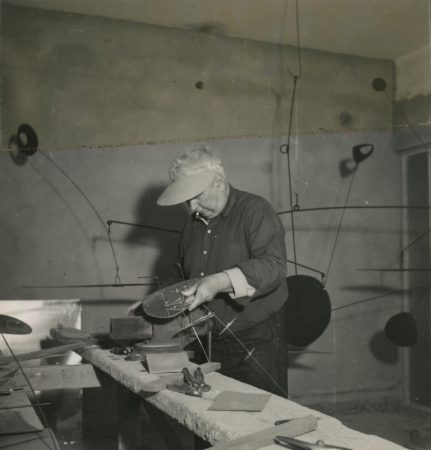
American University, Beirut, exhibits works Calder made during the last month.
CF, exhibition fileThe Calder family visits Jerusalem and Bethlehem.
CF, passport; CF, Calder to mother, 9 FebruaryThe Calders leave Beirut by plane and return to Aix.
CF, passport; Calder 1966, 227Calder leaves Paris, traveling through Amsterdam to Hanover, where an exhibition of his work is scheduled to open at the Kestnergesellschaft.
CF, passportKestnergesellschaft exhibits “Alexander Calder: Stabiles, Mobiles, Gouaches.”
CF, exhibition fileCalder returns to Paris.
CF, passportLouisa and daughter Mary sail from Le Havre to New York.
CF, passportCalder flies from Paris to New York; daughter Sandra remains in France.
CF, passport; Calder 1966, 231The renovation of François Premier is completed.
CF, Davidson to Calder, 24 JulyCalder’s dealer, Curt Valentin, dies in Italy.
Calder 1966, 231Belgiojoso, Peressutti & Rogers of Milan build a labyrinth for the X Triennale di Milano at the Uffici Palazzo dell’arte al Parco. Calder’s Le Cagoulard is installed in the center, and Saul Steinberg’s drawings are on the walls.
CF, project fileCalder returns to France, arriving in Le Havre.
CF, passportGalerie Maeght, Paris, exhibits “Aix. Saché. Roxbury. 1953–54.” The catalogue texts are “Poème offert à Alexander Calder et à Louisa” by Henri Pichette and “Calder” by Frank Elgar.
CF, exhibition file
Calder leaves Paris and arrives in New York.
CF, passportA visa is issued for the Calders’ trip to India. Calder and Louisa have been invited by Gira Sarabhai, an architect and designer, to a tour of India in exchange for works of art.
Calder 1966, 231–32Calder and Louisa leave New York and arrive in Paris.
CF, passport1955
En route to Bombay, Calder and Louisa fly from Paris to Beirut. They visit the Seyrigs and show the film Works of Calder at the American University.
CF, passport; Calder 1966, 232The Calders arrive in Bombay. They journey by train to Gira Sarabhai’s home in Ahmedabad, where Calder makes eleven sculptures and some gold jewelry.
CF, passport; Calder 1966, 232–33
After visiting Patna, the Calders arrive in Kathmandu in Nepal.
CF, passportThe Calders leave Kathmandu for Patna from which they visit Delhi and Jaipur before returning to Bombay.
CF, passport; Calder 1966, 232–40Calder has a private exhibition in Bombay of the works he has made in India. He contracts pneumonia and stays a few extra days to recover.
Calder 1966, 239–40The Calders leave Bombay, returning to Paris via Cairo and Athens.
Calder 1966, 240; CF, passportThe Calders fly from Paris to New York.
CF, passportJehangir Art Gallery, Bombay, exhibits Calder’s work.
CF, exhibition fileCalder gifts Varda a mobile for photographing him and his work over the years. I asked Foinet to give you a mobile—your choice—among many, of a medium size that I left at the studio.
CF, Calder to Varda, 12 MayCurt Valentin Gallery, New York, exhibits “Alexander Calder.” Calder agrees to hold the show as scheduled, in spite of Valentin’s death the previous year. Nothing sells.
Calder 1966, 240Calder arrives in Caracas. He sets up a studio at the metal shop of the Universidad Central de Venezuela and sees Acoustic Ceiling installed in Aula Magna for the first time. Louisa plans to join Calder in Caracas, but a tornado hits Connecticut and causes extensive flooding; she
cancels her trip.
Villanueva arranges “Exposición Calder” at Museo de Bellas Artes, Caracas.
Calder 1966, 242; CF, exhibition file
Calder leaves Caracas, arriving in New York en route to Roxbury.
CF, passportThe Calders arrive in France for the marriage of their daughter, Sandra, to Jean Davidson.
CF, passport; Calder 1966, 246Sandra Calder and Jean Davidson are married in Saché. As a wedding present, Miró gives Sandra a drawing.
Calder 1966, 246; CF, object file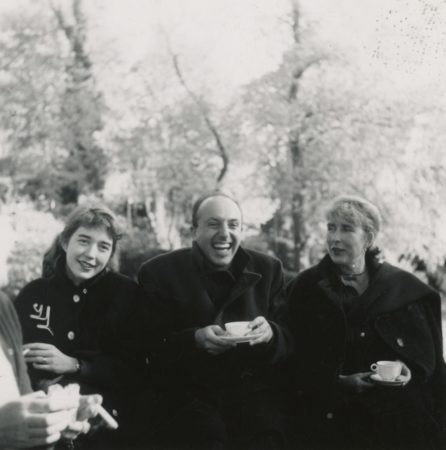
The Calders and Davidsons leave Paris and arrive in Germany, where Calder has been commissioned to make a stabile for the American Consulate in Frankfurt. The Calders stay at the Frankfurter Hof. Calder works with the bridge builders Fries et Cie to construct the monumental
stabile Hextopus.
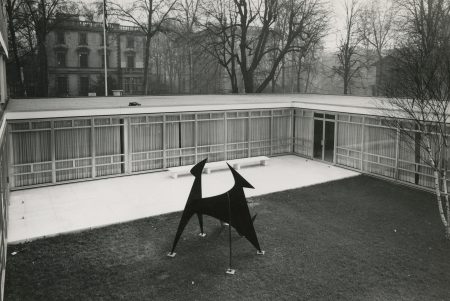
The Calders return to France by car.
CF, passportFrom Paris, the Calders take a train to Brussels. They fly to New York and return to Roxbury.
CF, passportPantheon Books publishes A Bestiary, edited by Richard Wilbur, with illustrations by Calder.
CF, project file1956
Perls Galleries, New York, exhibits “Calder.” This is Calder’s first show with his new dealers, Klaus and Dolly Perls.
CF, exhibition fileThe Calders arrive in France.
CF, passportThe Calders drive to Italy, entering via Ponte S. Luigi. While in Rome they stay at the foot of the Janiculum Hill, where Calder sets up a studio.
CF, passport; CF, del Corso to Calder, 6 FebruaryGalleria dell’Obelisco, Rome, presents “Calder,” which travels to Galleria d’Arte del Naviglio, Milan, and Circolo della Cultura e delle Arti, Trieste.
CF, exhibition fileThe Calders leave Italy for France.
CF, del Corso to Calder, 16 AprilThe Calders leave Paris, arriving in New York en route to Roxbury.
CF, passportCalder completes his fountain commission Water Ballet for the General Motors Technical Center, Warren, Michigan. There is a dedication on 15 May.
CF, Saarinen to Calder, 27 April; CF, Dinkeloo to Calder, 17 May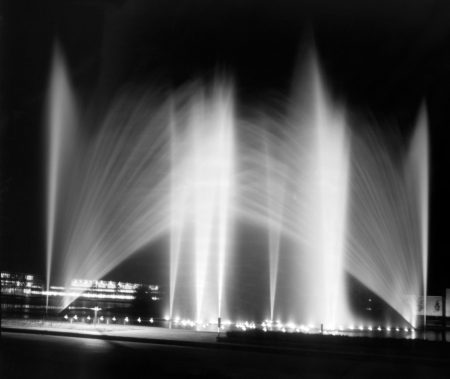
The Calders arrive in Paris en route to Saché.
CF, passportThe Calders’ grandson, Shawn Davidson, is born in Tours, France, to Sandra and Jean Davidson.
Calder 1966, 252The Institute of Contemporary Art, Boston, exhibits “Jewelry and Drawings by Alexander Calder.” Forty-one pieces of jewelry are exhibited.
CF, exhibition fileThe Calders fly from Paris to New York.
CF, passport1957
Arnold Newman photographs Calder in his Roxbury home and studio.
CF, photography file
Frank Perls Gallery, Beverly Hills, exhibits “Alexander Calder.”
CF, exhibition fileCalder attends the screening of 8×8: A Chess Sonata in 8 Movements at the Museum of Modern Art. Directed by Hans Richter, the film brings together Arp, Paul Bowles, Calder, Cocteau, Duchamp, Kiesler, Jacqueline Matisse, Sert, and Tanguy, among others.
CF, project fileThe Committee of Art Advisors at UNESCO approves Calder’s maquette for a standing mobile. Titled Spirale, the mobile top is made by Calder at Segré’s Iron Works in Connecticut and the stabile bottom is made with the collaboration of Jean Prouvé in France.
CF, Evans to Calder, 15 MarchIllustrator Réne Bouché draws a portrait of Calder with Louisa and daughter Mary in Roxbury.
CF, object fileAt Waterbury Iron Works in Connecticut, Calder finishes the mobile commissioned by the Port Authority of New York. He initially titles it .125, the gauge of the aluminum elements, although the work is later dubbed Flight. The mobile is placed in a storeroom near the International Arrivals
Building of Idlewild Airport (now John F. Kennedy International Airport), where it is to be installed upon completion of the terminal.
The Calders and daughter Mary arrive in Paris.
CF, passportWhile visiting Ritou Nitzschke and André Bac in La Roche Jaune, Brittany, the Calders buy an old customs house, Le Palud, located at the mouth of the Tréguier River. A few times a year, at high tide, the house site becomes an island.
CF, Louisa to Nanette, 8 July; Calder 1966, 252–53
The family arrives in Spain for a visit with Peter Bellew (writer) and his wife Ellen. They also visit Artigas, a ceramicist, in Gallifa (Barcelona) before returning to France.
CF, passportUffici Palazzo dell’Arte al Parco, Milan, exhibits the XI Triennale di Milano. Calder makes the stabile Funghi Neri, enlarged from a maquette for the exhibition.
CF, exhibition and project filesThe Calders and daughter Mary leave Paris for London.
CF, passportThe Calders and daughter Mary leave London and arrive in New York.
CF, passportCalder and Louisa see .125 installed in the International Arrivals Terminal of John F. Kennedy Airport for the first time.
CF, project file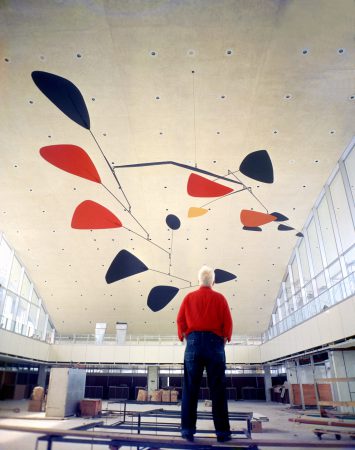
1958
Calder completes the motorized, monumental sculpture The Whirling Ear, a commission made for the pool in front of the United States Pavilion at the Brussels Universal and International Exhibition. The sculpture was made by Calder at Gowans-Knight in Watertown,
Connecticut.

Perls Galleries, New York, exhibits “Calder, Recent Works.”
CF, exhibition fileCalder builds a second studio in Roxbury.
Lipman 1976, 335The Glory Folk, a ballet choreographed by John Butler with sets by Calder, is performed during the “Festival of Two Worlds,” Spoleto, Italy. Calder flies to Spoleto to oversee the construction of his sets.
CF, project fileThe Calders arrive in Paris.
CF, passportCalder installs Spirale, a monumental standing mobile, at UNESCO in Paris and attends the dedication ceremony on the following day.
Calder 1966, 258–59
The Calders arrive in New York.
CF, passportCarnegie Institute, Pittsburgh, presents the 1958 Pittsburgh Bicentennial International Exhibition of Contemporary Painting and Sculpture. Calder wins first prize in the sculpture category for Pittsburgh, a monumental mobile, which is purchased by G. David Thompson
and donated to Allegheny County. It is installed at the Greater Pittsburgh International Airport.
1959
Calder goes to Paris to arrange a solo exhibition at Galerie Maeght.
FJM, Calder to Prats, 24 MarchGalerie Maeght, Paris, exhibits “Calder: Stabiles.” The catalogue texts are “Stabiles” by Georges Salles and “Le Luron aux protège-genoux” by Jean Davidson, with illustrations by Calder.
CF, exhibition file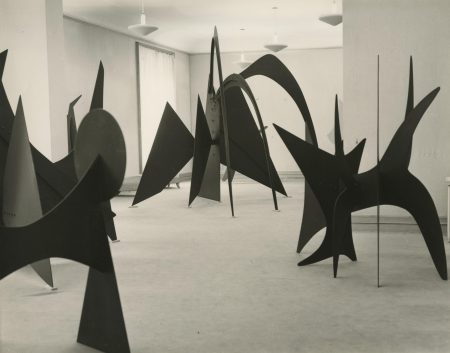
Calder leaves Paris.
FJM, Calder to Prats, 24 MarchCalder leases an apartment for daughter Mary at 20 Jones Street in New York City.
CF, lease agreementStedelijk Museum, Amsterdam, exhibits “Alexander Calder, Stabilen, Mobilen.” The catalogue texts are “Stabiles” by Georges Salles and “Calder und die mobiles” by Willem Sandberg. The exhibition travels to Hamburg, Krefeld, Mannheim, Wuppertal, and Zurich.
CF, exhibition fileCalder and Louisa host dinner at their home in Roxbury in honor of the AICA (International Association of Art Critics) XIth General Assembly.
CF, business fileThe Calders arrive in the Netherlands.
CF, passportThe Calders arrive in Le Bourget, France.
CF, passport“American Painting and Sculpture 1930–1959: The Moscow Exhibition” is included as part of the American National Exhibition in Sokolniki Park, Moscow. Calder contributes Black Mobile and 7 Legged Beast.
CF, exhibition fileThe Calders receive a visa from the Brazilian Consulate in Paris.
CF, passportThe Calders depart Paris and arrive in Rio de Janeiro, where they spend a month at the Gloria Hotel. During their stay, they visit Brazil’s new capital, Brasília.
CF, passport; Calder 1966, 253The Calders leave Brazil.
CF, passport1960
Calder is elected to the National Institute of Arts and Letters, New York, and is inducted on 25 May.
CF, awards fileThe Calders return to Brazil for the Carnaval.
CF, passportThe Calders leave Brazil, returning to the United States.
CF, passportBibliography 314
1953
Morris, George L. K. “La Sculpture Abstraite aux U.S.A.” Art d’ Aujourd’hui (January 1953).
MagazineGheerbrant, B. “Permanence du Cirque.” Arts (2 & 6 January 1953).
MagazineKreuther, Hellmut. “Der amerikanische Glasperlenspieler.” Der Kurier (Berlin), 19 January 1953.
Newspaper“Courrier International des Arts.” Arts (16 & 22 January 1953).
MagazineThe Museum of Modern Art, New York. The Unknown Political Prisoner. Exhibition catalogue. 1953.
Group Exhibition Catalogue“Calder’s Airborne Sculpture.” School Arts, vol. 52, no. 6 (February 1953).
MagazineSchumann, Werner. “Drei Berliner Künstler.” Die Neue Zeitung, 10 February 1953.
NewspaperHanna Bekker vom Rath/Frankfurter Kunstkabinett, Frankfurt am Main, Germany. Alexander Calder, Paul Fontaine, Louise Rösler. Exhibition catalogue. 1953.
Group Exhibition CatalogueDavis, Richard S. “Cedarburg on Verge of Fame for Its Mobile.” The Milwaukee Journal, 25 February 1953.
Newspaper“Mobiles Give Advertisers a New Medium.” Business Week (28 February 1953).
MagazineTate Gallery, London. The Unknown Political Prisoner. Exhibition catalogue. 1953. Foreword by Herbert Read.
Group Exhibition CatalogueWalker Art Center, Minneapolis. Alexander Calder Mobiles. Exhibition catalogue. 1953.
Solo Exhibition CatalogueMeta Mold Aluminum Company, Cedarburg, Wisconsin. An Exhibition of Contemporary Art Collected by American Business. Exhibition catalogue. 1953.
Group Exhibition CatalogueSherman, John K. “Don’t Let That Space Dangle There Empty.” Minneapolis Tribune, 10 April 1953.
NewspaperMusée National d’Art Moderne, Paris. 12 Peintres et Sculpteurs Américains Contemporains. Exhibition catalogue. 1953.
Group Exhibition Catalogue“Autour de ‘Nucléa.’” Numero, no. 3 (May–June 1953).
MagazineGoodall, Donald. “Los Angeles.” Art Digest (June 1953).
MagazineYoung, Villette. “Maker of Mobiles.” Hartford Courant Magazine (21 June 1953).
MagazineRogers, W. G. “Sculpture on the Move Is the Calder Specialty.” (Publicaton unknown), 28 June 1953.
NewspaperMeta Mold Aluminum Company, Cedarburg, Wisconsin. Art For Everyone. Exhibition catalogue. 1953.
Group Exhibition CatalogueJoffroy, Pierre. “Calder.” Paris Match, no. 233 (12 September 1953).
MagazineRay, E. Roy. “Much Ado About Mobiles.” Hartford Courant Magazine (11 October 1953).
MagazineWadsworth Atheneum, Hartford. Alexander Calder: Mobiles / Naum Gabo: Kinetic Constructions and Constructions in Space. Exhibition catalogue. 1953. Text by Charles E. Buckley.
Group Exhibition Catalogue“Sweeney Calls Moderns Explorers in Sculpture.” Hartford Times, 28 October 1953.
NewspaperSchmidt, George. “Alexander Calder’s ‘Mobiles.’” Du (Zurich), vol. 13 (December 1953).
MagazineMuseu de Arte Moderna, São Paulo, Brazil. II Bienal do Museu de Arte Moderna de São Paulo. Exhibition catalogue. 1953. Introduction by Sergio Milliet.
Group Exhibition CatalogueCurt Valentin Gallery, New York. Sculpture and Sculpture Drawings. Exhibition catalogue. 1953.
Group Exhibition Catalogue1954
Bruguière, Pierre-Georges. “L’objet-mobile de Calder.” Cahiers d’Art, vol. 29, no. 2 (1954).
MagazineArroyo, Miguel. “Muebles Modernos para una Casa Colonial.” A. Hombre y Expresión (January 1954).
MagazineBaukunst und werkform, no. 10 (1954).
MagazineStably, Francois. “The University Centre of Caracas.” Graphis (1954).
MagazineVieira, José Geraldo. “No Palacio das Nações.” Folha da Manhã, 3 January 1954.
NewspaperLouchheim, Aline B. “Cultural Diplomacy: An Art We Neglect.” New York Times Magazine (3 January 1954).
Magazine“Novembre a Paris.” Vogue (November 1954).
MagazineEl Farol, no. 150 (February 1954).
Magazine“Kunst oder Spielerei?” Sonntagsblatt, 28 February 1954.
NewspaperKestnergesellschaft, Hanover, Germany. Alexander Calder: Stabiles, Mobiles, Gouachen. Exhibition catalogue. 1954. Text by Alfred Hentzen; reprinted text by Jean-Paul Sartre.
Solo Exhibition CatalogueDegand, Léon. “Les Spectacles A Paris: Le Cirque Calder.” Le Soir, 8 May 1954.
Newspaper“Agamemnon on Time.” Time, vol. 63, no. 21 (24 May 1954).
MagazineGalerie Rudolf Hoffmann, Hamburg, Germany. Calder. Exhibition catalogue. 1954. Foreword by Christian-Adolf Isermeyer.
Solo Exhibition CatalogueFriedman, Shirley. “Creator of Wired Sculpture Chides Form’s Adulterators.” Newark Evening News, 22 July 1954.
Newspaper“Originator of ‘Mobiles’ Comments on This Art.” Newark Evening News, 28 July 1954.
NewspaperDegand, Leon. “Essai d’Integration des Arts.” Art d’Aujourd’hui, no. 6 (September 1954).
MagazineGalerie Maeght, Paris. Aix. Saché. Roxbury. 1953–54. Exhibition catalogue. 1954. Derriére Le Miroir, nos. 69–70 (13 November 1954). Poem by Henri Pichette; text by Frank Elgar.
Magazine, Solo Exhibition CatalogueDunbar, Jack. “Letter from the Tenth Triennale.” Industrial Design, no. 5 (October 1954).
MagazineJotterand, Franck. “Alexandre Calder ou la sculpture en mouvement.” France Illustration, no. 416 (November 1954).
MagazineSpirale (November 1954).
Magazine“The Children’s Labyrinth.” Interiors (November 1954).
Magazine“Il labirinto dei ragazzi.” Casabella Continuita, no. 203 (November–December 1954).
MagazineCrespelle, J.-P. “Avec ses ‘mobiles’ l’Américain Calder s’apprête à revolutionner le cadre de notre vie.” France-Soir, 13 November 1954.
NewspaperVancouver Art Gallery. The Solomon R. Guggenheim Museum, A Selection from the Museum Collection. Exhibition catalogue. 1954.
Group Exhibition Catalogue“Calder le sculpteur qui voudrait être le Bon Dieu.” Jours de France (18–25 November 1954).
MagazineBuchwald, Art. “Europe’s Lighter Side.” New York Herald Tribune, 18 November 1954.
NewspaperJouffroy, Alain. “Calder.” Arts (24 & 30 November 1954).
Magazine“Galeries d’Art.” France-Observateur (25 November 1954).
Magazine“Bewegingskunst die een beweging kan worden.” (Publication unknown), 26 November 1954.
NewspaperVillanueva, Carlos Raul. “El Centro Comunal de la Ciudad Universitaria de Caracas.” Ver y Estimar, no. 2 (December 1954).
Magazine“XT: The Shapes to Come.” Fortune (December 1954).
MagazineMusée National d’Art Moderne, Paris. Le Dessin Contemporain Aux États-Unis. Exhibition catalogue. 1954.
Group Exhibition Catalogue1955
The Lefevre Gallery, London. Mobiles by Calder. Exhibition catalogue. 1955.
Solo Exhibition CatalogueLe Grand Cirque Calder 1927 (1955). 16mm, color, sound (French); 45 min. Directed by Jean Painlevé with Geneviève “Ginette” Hamon, assistant; cinematography by Claude Beausoleil; sound direction by Freddy Baume.
FilmWilbur, Richard, ed. A Bestiary. New York: Pantheon Books, 1955.
Illustrated Book“Alexander Calder.” Informations et Documents (1 January 1955).
MagazineCity Art Museum of St. Louis, Missouri. A Tribute to Curt Valentin. Exhibition catalogue. 1955.
Group Exhibition CatalogueThe Pennsylvania Academy of Fine Arts, Philadelphia. The One Hundred and Fiftieth Anniversary Exhibition. Exhibition catalogue. 1955.
Group Exhibition CatalogueLebel, Robert. “Calder et la nouvelle sculpture.” Preuves (February 1955).
Magazine“Inventor of Mobile Sculpture.” Times, 7 February 1955.
Newspaper“From Shantiniketan.” Anandabazaar Patrika (Bengal), 1 March 1955.
NewspaperMusée National d’Art Moderne, Paris. Modern Art in the United States. Exhibition catalogue. 1955.
Group Exhibition Catalogue“Something for the Breeze.” Mechanix Illustrated (April 1955).
MagazineGalerie Denise René, Paris. Le Mouvement. Exhibition catalogue. 1955.
Group Exhibition CatalogueR. V. G. “Le Mouvement: Propositions pour une plastique cinetique.” Les Beaux-Arts a Paris (22 April 1955).
MagazineGraduate School of Design, Harvard University, Cambridge, Massachusetts. Calder. Exhibition catalogue. 1955.
Solo Exhibition Catalogue“Mobiles at The Lefevre Gallery.” Studio (May 1955).
MagazineVernis. “L’arte é mobile.” Connoisseur, vol. 135 (May 1955).
MagazineDuveen-Graham, New York. Attilio Salemme, 1911–1955. Exhibition catalogue. 1955.
General ReferenceAdlow, Dorothy. “Mobiles and Stabiles on Display at Harvard.” Christian Science Monitor, 2 May 1955.
NewspaperHandy, Mary. “Mobiles Inspire Harvard Students of Design.” Christian Science Monitor, 10 May 1955.
NewspaperCurt Valentin Gallery, New York. Alexander Calder. Exhibition catalogue. 1955.
Solo Exhibition CatalogueGenauer, Emily. “Mobiles, Michelangelo May Express Same Ideas.” New York Herald Tribune, 22 May 1955.
Newspaper“Calder.” Art Digest, vol. 29 (June 1955).
Magazine“Mobiles.” Marie-France (4 July 1955).
MagazineMuseum Fridericianum, Kassel, Germany. Documenta: Kunst des XX. jahrhunderts: Internationale Ausstellung. Exhibition catalogue. 1955.
Group Exhibition CataloguePineda, Rafael. “El Hombre y su Huella.” El Nacional, 25 August 1955.
NewspaperPosani, Juan Pedro. “Resenas.” A. Hombre y Expresión (September 1955).
Magazine“Colección de Móviles de Alexander Calder en Museo de Bellas Artes.” El Universal, 8 September 1955.
NewspaperMuseo de Bellas Artes, Caracas, Venezuela. Exposiciòn Calder. Exhibition catalogue. 1955. Foreword by Alejo Carpentier; reprinted texts by Jean-Paul Sartre and Fernand Léger; handwritten statement by Calder.
Solo Exhibition CatalogueJack and Jill (October 1955).
Magazine“The Latin American Look.” Time (Latin American, 12 December 1955).
Magazine1956
De Grassi, Leonard R. “A Calder Trigraph: A Study of American Criticism as Applied to Three Generations of Calder Style (to 1948).” Master’s thesis, University of Southern California, 1956.
Unpublished Document or ManuscriptRogers, William G. “Man and Mobile.” Manuscript, 1956. Calder Foundation, New York.
Unpublished Document or ManuscriptMumford, Lewis. New Yorker (4 February 1956).
MagazineGenauer, Emily. New York Herald Tribune, 12 February 1956.
NewspaperC., L. “Alexander Calder.” Art News, vol. 55 (March 1956).
Magazine“Portrait.” Art in America, vol. 44 (Spring 1956).
Magazine“Lyre Bird.” Poetry London-New York, no. 1 (March–April 1956).
MagazineBreuning, Margaret. “Margaret Breuning Writes:” Arts (March 1956).
MagazineActualite Litteraire (March 1956).
Magazine“Un grande artista: Alexander Calder.” Gazzetta Ticinese, no. 55, 6 March 1956.
NewspaperAllemande, Maurice. “A Saint-Etienne.” Prisme des Arts (15 March 1956).
Magazine
